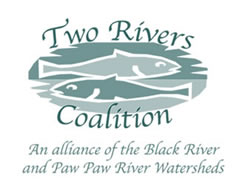Home>The Watersheds>Black River Watershed>Cedar Creek-South Branch
Cedar Creek-South Branch Sub Watershed
From watershed management plan:
Priority areas are those portions of the watershed that contribute, or have the potential to contribute, the most pollutants that impact water quality. By identifying priority areas, implementation can be targeted to the areas where most benefit can be achieved. The watershed was prioritized at the sub watershed level into priority levels 1 through 3. Priority area 1 is the highest priority area to be addressed with action in the watershed.
Cedar Creek - South Branch Sub Watershed is a Priority 1 area.
Goals in Objectives for the Black River Watershed:
- Improve water quality and habitat for fish, indigenous aquatic life and wildlife in the watershed by reducing the amount of nutrients, sediment, and chemical pollutants entering the system
- Stabilize priority streambank erosion sites through the installation of corrective measures
- Establish a road/stream crossing improvement program to correct identified problems
- Work to limit or control direct livestock access to the river and tributaries
- Install corrective measures to reduce runoff at agricultural sites of concern (cover crop, reduced/no tillage, buffer strips)
- Encourage farmers to participate in the Michigan Agriculture Environmental Assurance Program (MAEAP)
- Reestablish greenbelts/conservation buffers at sites in critical areas
- Work with communities to reduce polluted stormwater entering local waterways – utilize low impact development
- Identify and improve failing septic systems
- Encourage the creation of local sanitary sewer systems on densely populated inland lakes
- Continue/increase watershed monitoring efforts and stewardship
- Perform water quality monitoring for potential pollutants to monitor the current quality of the river as well as to monitor changes over time
- Continue monitoring stream bank erosion
- Continue geomorphologic assessments of river
- Perform hydraulic / hydrologic analysis of river
- Improve the hydrology and morphology of the river
- Reduce volume and rate of runoff using recommendations from hydrologic study (see Appendix N). BMPs include wetland creation, detention, bioretention, buffer strips and infiltration practices
- Restore river channel to stable condition
- Provide long-term protection of the Black River Watershed through improved local land use policies and conservation practices
- Assess the current adequacy level of local community planning and zoning controls
- Develop model ordinances and language for adoption into existing master plans and zoning ordinances
- Assist local communities in updating master plans and/or adopting ordinances or “smart growth” or low impact development techniques that will protect water quality
- Permanently protect identified sensitive areas through conservation easements, purchase of development rights, and land purchases
- Support efforts to protect prime farmland from development
- Promote Low Impact Development (LID) techniques through regulations or incentives
- Improve the navigability of the Black River for canoes, kayaks, and other self-propelled watercraft, by reducing sedimentation and reducing excess woody debris
- Remove or cut through downed trees that inhibit navigation by canoes and kayaks and increase bank erosion
- Stabilize priority streambank erosion sites through the installation of corrective measures (see objective 1 A)
- Establish a road/stream crossing improvement program to correct identified problems (see objective 1 B)
- Work to limit or control direct livestock access to the river and tributaries (see objective 1 D)
- Enhance recreational access sites to prevent the degradation of water quality
- Increase the number of legal access sites
- Provide educational kiosks and signage at launch sites that educate people about the watershed and good river etiquette
- Increase knowledge and participation in programs regarding nonpoint source pollution and means of prevention
- Hire staff to implement watershed management plan, including a project manager and a land use planner
- Implement Information & Education Plan (see Appendix Q)
- Prevent the introduction of, and minimize the negative impact of, invasive species within the basin.
- Establish or work with existing invasive species control programs to prevent the spread of exotic species in the watershed
This page last updated on 3/19/2023.

